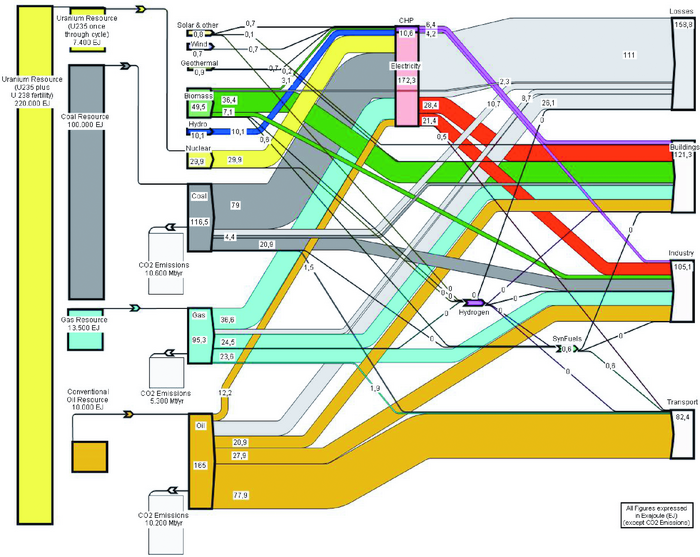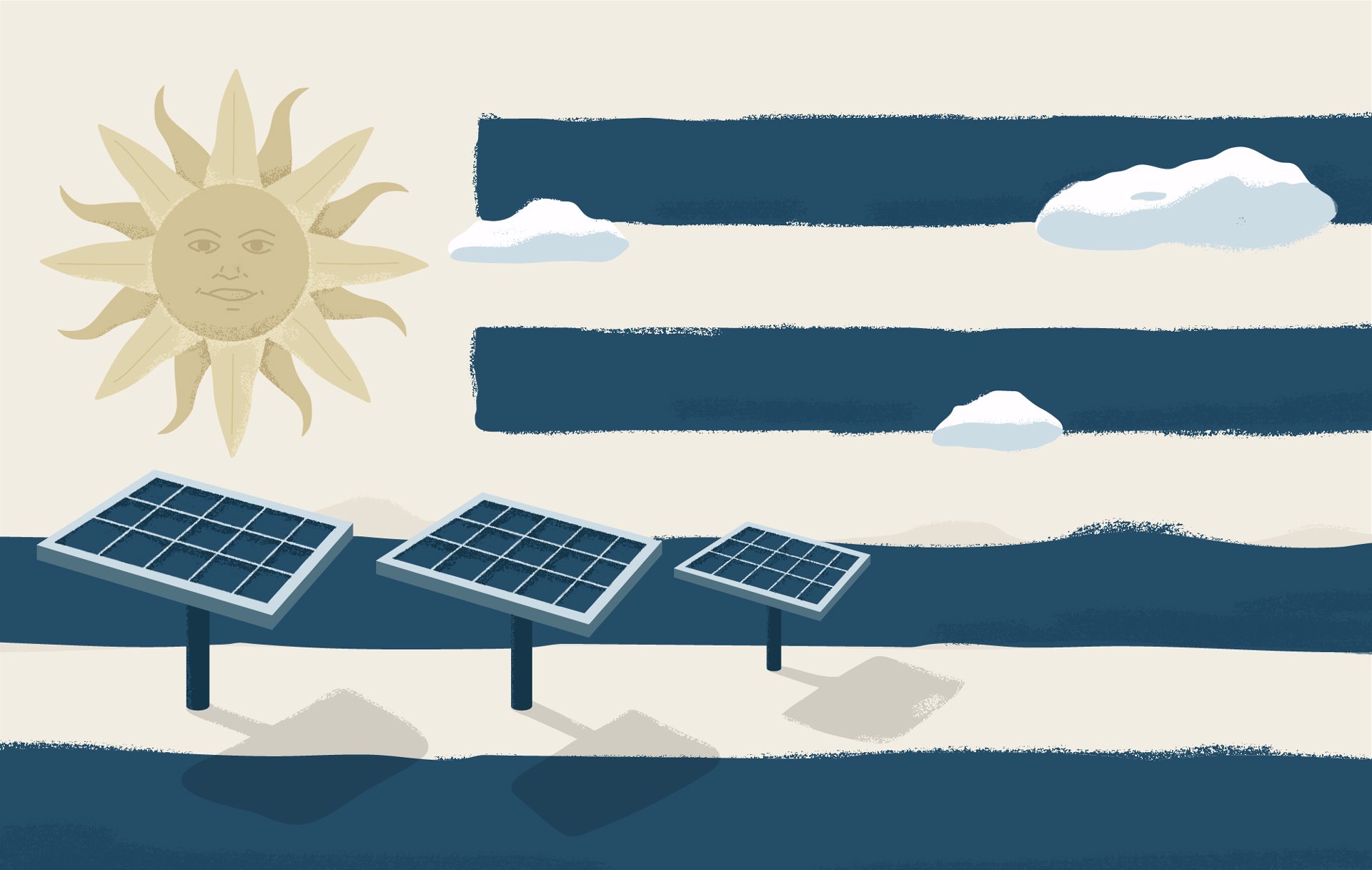“with wind the single-biggest contributor… Power production costs have declined “by almost half” … And the clean energy sector has created 50,000 new jobs… Ask me what was the impact on the electricity sector in Uruguay after this tragic war in Europe — zero.”
I actually never thought of it like that, if you’re not partaking in the trade of fossil fuels, you are removing yourself from a lot of potential conflicts and “who support who” ordeals.
One of the main reasons the big players want (or even need) as many people globally to remain dependent on it as possible - control.
That and petrolheads in politics. Who is so slow in renewables? USA and Germany.
Carter tried to show the US the future but then he got replaced with Bad Human 1.0 Ronnie and it was all trashed.
Germany has the most renewables per capita of any European nation and have been heavy investors for a long time now.
They are a bit better now, but especially during Merkel were some heavy stones laid on the way for wind. Ok, i admit, they are good in private solar now.
Yes, I think that one of the side effect of the war in Ukraine will be a big increase of renewables energy in Europe.
European countries started to realize how fragile their energy supply is and how dangerous it is.
Sadly, in the meantime it also mean a surge of imports of fossil fuels from other countries and reopening extraction sites in EU. Reducing fossil fuel dependency really is the top priority of EU, not only for ecology but also for peace and for the economy.
Wait until we have our first Wind War.
That’s what we call it after eating beans all day
We call it Aladdin’s revenge. Turning the blanket into a flying carpet and all that.
We’ll control the wind and rain. It was a saying in soviet block during cold war and elites really thought they would. By spraying chemicals in clouds etc. Disgusting.
Cloud seeding? That’s very much a real thing, although its effectiveness is disputed.
A bit of info about an “experiment” on the subject https://en.m.wikipedia.org/wiki/Operation_Popeye
…Except China, where most renewables are produced.
Except once you have the turbines and panels, you don’t have to keep importing resources to run them. Sure, you might need parts for maintenance, but if things go south it’s a lot easier to reverse engineer parts than to find new oil suppliers.
Only because they produce them the cheapest and in the largest quantities (which goes hand in hand).
Basically any country can produce solar panels and wind turbines. Both technology and resource wise.
deleted by creator
We’ve been at ~95% renewable for years actually, but now we’ve reached 100%
How do you cope when there is cloudy without wind?
They also have hydropower which provides a constant base load, and basically they have just heavily optimised their distribution of power to be very efficient. In emergencies they are also able to import power from neighbouring countries.
There are ways to store the power generated by renewables.
There are, but none is feasible today when it comes to mass storage. Or is there one?
There is actually. Pumped Storage hydro uses the energy as it’s generated from renewables and uses it to pump water up into a reservoir. Once you have the water pumped, it’s just a matter of letting the water back out through turbines. Their efficiency is somewhere around 80% which is pretty good.
For that you need both suitable hills and water. Also it’s not that huge, it certainly depends on the reservoir capacity. If it was a feasible solution, then you’d see them everywhere, but you don’t. Ask Germans about it.
How often is there no wind anywhere?
How cloudy does it have to be so you can’t generate power?
Is it possible to store power?
Looks like that’s just the grid? I’m sure there’s more to go for transportation and eliminating the need for generators and gas, but this is a great start!
does anyone ever assume that it’s anything other than the grid when it comes to some article like this?
electricity is’t the majority of the energy consumed in nearly any country.
it’s a easy way to keep confusing less vigilant people by calling electricity as energy.
Just call things the way they are.
You’re right; 2/3 of worldwide energy is actually waste heat.
https://www.businessinsider.com/most-energy-still-comes-from-oil-2015-10
Here’s the chart from 2007: Waste heat / losses are in the top right, although it doesn’t show the transport sector losses which are higher than for coal generation.

What this means is that when we fully electrify all sectors, by using renewable energy such as wind and solar, our total energy generation capacity will only need to be about 1/3 to 1/4 of what we currently produce today to fulfill our current energy needs. That’s huge.
that’s not quite right and mixes couple things
you have production losses and transmission losses. then you have waste heat used for household and industrial heating.
now you would also have to produce that portion electrically.
For instance in winter heating requirements of a typical house are 2x that of the electricity used.
Electrically independent doesn’t have the same ring to it
I mean I doubt any reasonable person would think that literally every household in Uruguay has replaced their gas stove with an electric/induction stove and that they use only AC/heat pumps and everyone has switched to an electric car and every bus has been converted to a trolley and or Battery/Hydrogen Electric
and a bunch of other stuff.
Too bad it’s far too late.
Meanwhile in South Africa, we’re having blackouts while being almost completely dependant on coal.
But I bet the companies make a lot of profit on that, so all good \s
Amazing
I wonder how much of that is biomass, and how they’re planning to grow enough vegetation to renew iy
https://app.electricitymaps.com/zone/UY
You can select 30d, year… And see how much was used for that period.
Not too much biomass fortunately. But even with some googling I can’t seem to find how anyone plans to produce enough biomass to keep this going
53% of power currently being generated by wind, the rest hydro. So there you go. They seem to be doing it, so there’s your answer.
Yes they have multiple forms of energy generation, that does not answer the question as to wether their biofuel is sustainable. Yes it’s carbon neutral (ish) but can they produce the biomass as fast as they consume it?
deleted by creator
What is that unknown bar meant to be?
I don’t know how much I trust that website. It states that British Columbia has 100% of its power generation from an unknown source, which it labels as “500 grams per kwhr” equivalent to coal. But we know that 100% of British Columbia’s electricity comes from hydro…
They seem to be using publicly available data.
You can see here the source for the Uruguay https://apps.ute.com.uy/SgePublico/ConsPotenciaGeneracionArbolXFuente.aspx
The website’s number of 500g / kilowatt hour is completely wrong.
This is what BC hydro says:
An efficient, low cost electricity system for B.C. More than 90% of BC Hydro’s generation is produced by hydroelectric generation, which is generally the most cost-effective, clean and reliable option. We also continue to investigate alternative sources of energy, such as wind and wave power.
We generate over 43,000 gigawatt hours of electricity annually to supply more than 1.9 million residential, commercial and industrial customers.
Over 80% of BC Hydro’s installed generating capacity is at hydroelectric installations in the Peace and Columbia river basins.
About 87% of electricity in B.C. is produced from hydroelectric sources. B.C. is home to roughly 16 000 MW of hydroelectric capacity, most of which is located on the Columbia River in southeastern B.C. and the Peace River in the northeast. Site C, a new 1 100 MW hydroelectric facility, is currently under construction on the Peace River. The project is expected to be completed in 2025.
The greenhouse gas intensity of B.C.’s electricity grid Footnote 2 measured as the GHGs emitted in the generation of the province’s electric power, was 7.6 grams of CO2e per kilowatt-hour (g of CO2e per kWh) electricity generated in 2020. This is a 70% reduction from the province’s 2005 level of 24 g of CO2e per kWh. The national average in 2020 was 110 g of CO2e per kWh (Figure 8).
This aspect is a big aspect of intermittent renewables energy that is often dismissed: you need piloted energy as a backup, the amount of piloted energy depend on how oversized is the intermittent energy installation.
For renewable piloted energy there is two options that I know of: hydro and biomass. Uruguay is using both.
It’s something to keep in mind if we want to reach 100% renewables without nuclear, we need to increase the biomass electricity production.
On another hand we are already using a lot of biomass to produce ethanol and biodiesel. A lot of land is also use for animal feed, so I’m a society with less ICE cars and less meat eated we might have enough land to grow biomass for electricity generation.
Exactly, but I’m wondering how Uruguay is planning to go from a “might” to a “definitely” enough biomass production
I have no idea but I’m really interested to find out.
Actually one comment of many here set me on the right track! I’ll reply again when I find out!
Gotta get to the airport now tho, laters!
Biomass as a source of energy has a lot of the same problems as fossil fuels, no? Why is nuclear not on the table while biomass is?
Nuclear does not have the same function than biomass.
A biomass power station is (relatively) cheap to build but the fuel is expensive. So it make sense to have it as a backup and only use it when necessary.
On the other hand nuclear is expensive to build but the fuel is cheap. So building a nuclear power station as a backup does not make sense, it needs to run all the time.
This is the basic ideas, but in practice nuclear is actually beneficial to renewables. The electricity network operator did several scenarios for the French electrical production in 2050. In their scenarios, having around 13% of nuclear in the mix divided by almost two the amount of solar, wind turbines and batteries needed.
But nuclear is scalable while running, allowing you to ramp up and down as needed to cover for the intermittent nature of renewables without relying on fossil fuels or similar. Isn’t that why adding nuclear into the mix is such an effective strategy?
Well then it’s a good thing that’s United States produces 20 to 25% of its electricity through nuclear power generation. It would be a good idea to maintain that.
You can check it out in real time here: UTE Generation Biomass is not something so actively sought, it’s more of a consequence of other industries here. You are correct that we have other renewable sources that work when wind is not on its peak. There are two hidro plants that can work when demand is large and wind is not on its peak, and they’ve managed to keep this regime even on dry or draught conditions.
I’ll have to check later. It seems like the page is down, I’ll get back to you. thank you!
We really need to think of biomass as batteries. In both cases, it’s tough to scale up enough for full coverage but we know how to store biodiesel or ethanol, it’s very energy dense. Scattering a bunch of diesel generators with big biodiesel tanks might be a better answer than batteries for when the wind doesn’t blow
It also ensures a market and distribution industry for farming and construction vehicles where batteries may not work
It takes a decade and quite a bit of space to make a tree (for example), it’s technically renewable but the fuel production is very slow. I’m curious how they’re planning to keep that up
Other things grow faster and take up less space than trees. For example most biofuel is made from maize and sugarcane.
eyy thank you! That makes sense! You seem to be the only one to actually try to answer my question :/
I know where to look further! thank you!
No problem :) It was interesting to read a bit more about it. I reckon hemp would be the ultimate one though - super fast growing, will grow in most climates and really versatile for making fibers.
And the extra material wouldn’t go to waste! That is a good idea
Also how is biomass a battery? You can’t put energy back into a forest
Lots of devices still use batteries that do not recharge.
Yea, that’s the issue. For something to be sustainable, you need to replenish the fuel source. Biomass can be, but you need a lot of it, but we also need it for food
By that logic you could also not call the flat thing inside a phone a battery because it can’t feed back into the grid.
Other way round, you can take biomass and turn it into electricity easily. But you cant easily turn electricity into biomass. (it is easy on a phone to go both ways tho, google “USB c OTG adapter”)
Ever heard of AA batteries?
You burn it, and it generates electricity in a thermal plant. Or you can use it directly to heat a boiler to heat buildings.
how those middle east prince now can buy more hookers and supercars if u guys not using oil
Well done Uruguay.
53,000 barrels/day
It looks like Uruguays oil consumption has flatlined since about 2014. I can’t find any newer data than 2016 but here’s my source:
i think evs are still too expensive for the common uruguaian(?) wallet. so they still use oil for cars. but 4 months 100% renewables is great news.
Very cool. I hope they are looking at reducing demand for power as much as increasing production.
Actually, with clean sources of electricity like wind and solar, the amount consumption doesn’t matter. It only matters if there isn’t enough for everyone, or the power comes from non-green sources (coal etc)
I don’t understand the objection to greater efficiency… Even renewables are not without their own environmental costs of mining, transportation, manufucaturing etc. If we use less power we can more easily transition to renewables, with less disruption to the environment.
Was the wind blowing all night every night? Or do they have enough hydro (or another power source) to power then while the sun is down?
Ever heard of batteries?
Ever heard of insane amount of batteries required for that?
No, what are they?
“Hydropower provides a large percentage of installed production capacity in Uruguay, almost all of it produced by four hydroelectric facilities, three on the Rio Negro and one, the Salto Grande dam shared with Argentina, on the Uruguay River. The production from these hydropower sources is dependent on seasonal rainfall patterns, but under normal hydrological conditions, can supply off-peak domestic demand.” https://en.wikipedia.org/wiki/Energy_in_Uruguay
And they burn fossil fuels if necessary or import from Brazil it seems. They would have problems if a season is dry though.
deleted by creator
Nuclear fanbois: GASP! How dare you?!
Well, not every country has wind farms or water turbines as viable option. You know, geography and stuff…
I am not intending to add fuel to this fire of a comment thread, however I was wondering if Stockholm, Sweden’s solution of burning culled rabbits, for fuel, would be considered ‘reneweable energy’?
So which country has neither wind, water nor sunshine then?
For example Czech republic, Slovakia, baltic states, maybe Finland. It’s not like there’s none of these available. It’s they’re not really viable/meaningful options, yet. Sure you can build solar, but with nearly no sunlight in winter it’s almost useless for half the year…
deleted by creator
My country of Belgium. Unless by “100 % renewable” you include fossile gas generation “offset” by summer’s overproduction (which would be disingenuous).
Middle of January: 100% overcast for weeks on end with only 8 hours of daylight, some days with little to no wind. Geography does not support more hydro or any geothermal generation. Country is way too densely populated for meaningful biomass fuel production (not that it is a climate-friendly practice anyway).
Maaaybe there is a stretch argument to be made about offshore wind/water, but we have relatively little coastline and very busy waterways due to having some of the busiest shipping ports of Europe, so I doubt even in the most optimistic scenarios this can fill the gap during the winter season.
For any meaningful definition of the concept, we can’t be 100 % dependent on nationally-sourced renewables until we figure out much much denser and cheaper long term storage solutions. Which is alright - maintaining existing nuclear reactors is an option (barely due to legaislative sabotage pushed by the “greens” but a couple gigawatts is nothing to scoff at) and more importantly we are part of the EU which will hopefully allow us to buy southern European solar/wind via HVDC lines in the future, and we’re already very dependent on French nuclear. (Also we don’t have to be 100 % independent to push for renewables, perfect mustn’t be the enemy of good and all that)
allow us to buy southern European solar/wind
Yeah, I think this is the future for small, densely populated countries without clear sources of renewable energy
deleted by creator
Doesn’t Belgium just import electricity from the European energy grid? You guys have access to Norwegian hydro, German coal, and French nuclear.
Yes, in rather large amounts since we aren’t always self-sufficient (even with fossil gas).
Almost all of continental Europe is part of one, synchronous grid. Right now I’m using electricity simultaneously being produced in Belgium, Portugal, Ukraine, Turkey, and even Morocco; although for accounting purposes we calculate the difference at the border, electrons don’t care.
deleted by creator
You intentionally ignored the part about being overcast for weeks during the winter, the time of the year where they need the most energy. Tell me how solar can heat up the entire country when it’s overcast and there are only 8 hours of day light, which reminder, is covered by the overcast weather that stays for weeks
deleted by creator
Middle of January: 100% overcast for weeks on end with only 8 hours of daylight, some days with little to no wind.
deleted by creator
I think you are forgetting on part of the message.
Sure on average over the year you can produce enough electricity, but how do you heat houses in december, January and February when there is almost no sun ?
deleted by creator
Vatican City /s
I think that there are constraints for certain countries, but the majority probably could. And when they can’t, it should be solved by cooperation and trade, IMHO.
Then maybe those countries shouldn’t exist.
Though that’s based solely on your example.
I don’t understand the nuclear energy hate. Of the nonrenewables it is the cleanest, and it is not always possible to run 100% renewable, (they depend on natural factors such as sun or wind), while nuclear is constant and always producing. Look at Germany and how it is polluting using gas and fossiles, it would be a million times better it they used nuclear energy.
Decades and decades of fossil fuel company FUD about nuclear that they managed to get the greens to buy into a long time ago.
Even worse, they prematurely closed their nuclear power plants, even recently. 🤦♂️
Nuclear is just not practical. Even if you discount the risk of severe impact if anything ever goes wrong, and the long term impact on the environment if the fuel and waste chain. we’ve countless case studies that it’s just too expensive, too complex to build, too much putting all your eggs in one basket.
Making up some numbers but I think the scale is right …. Which would you choose:
— $12B and 10-20 years to build a nuclear plant, requiring highly specialized fuel and employees.all or nothing: you get no benefit the whole time it’s under construction so payback is multiple decades. Given the specialty fuel, employees, security, it’s the most expensive choice to operate
— $1B and 10-12 years to build a wind farm, but you start getting income as soon as sections come online. Fuel cost is zero and one being out for maintenance has negligible impact in production/profit. You get payback practically as soon as the project is built and it’s all gravy from there
Adding to this, while the wind doesn’t always blow, and the sun doesn’t always shine, nuclear needs water to evaporate. In a world where droughts during summer get ever more common, nuclear/coal is not the 24/365 solution it once was. The future has to rely on a diverse mix of different energy sources, if it wants to be resilient.
Coal is not affected by droughts, though. Nuclear for better or worse is the most reliable and clean source we know today. Biggest hurdle with renewables is storage. Let’s see if hydrogen is the way. But then again, storing large quantities of hydrogen might result in a big boom of something goes wrong.
AFAIK coal power plants often(always? Idk) use steam to drive their turbines in order to generate electricity. I’m not arguing against nuclear, but for a very diverse mix. Warm dry summer -> solar. Rainy dark winter -> hydro & wind. If we keep burning fossils, including nuclear, until we can switch to 100% renewals, I’m okay with that. The big advantage of renewals is the comparatively low cost of phases where no electricity is produced. A solar farm doesn’t generate cost at night. Coal and nuclear plants can’t just be “switched on and off” at will, and if they don’t produce, still need a lot more attention. But for the meantime, they are necessary, until we either overbuilt so much renewables to cover for “no wind/sun/rain” situations, or get some storage solutions (batteries, hydrogen, biofuels,…) Implement on a large enough scale.
That steam is closed circuit though. But yes, they need cooling water and perhaps pollution cleaning water. So I guess they are affected by droughts as well.
Because it’s an obvious psyop that took over almost every social media platform. No one was talking about nuclear then BOOM everyone was talking about nuclear all of a sudden with exactly zero mainstream public input from politicians or even marketing from nuclear power companies. People hate nuclear, because some of us have been alive long enough to remember Three Mile Island, Chernobyl, and Fukushima (the worst nuclear disaster in human history, 2011).
Here’s a list of every single nuclear meltdown/disaster/catastrophe https://en.wikipedia.org/wiki/Nuclear_and_radiation_accidents_and_incidents
The fission reaction to boil the water to spin the turbines is clean, but literally every single other facet of nuclear production, from mining, to enriching, to transport, to post-reaction storage (where nuclear waste inevitably always leaks) is disastrous for the environment.
I’m pretty sure you’re glossing over Germany replacing nuclear with coal, which has been probably been the largest story in nuclear since Fukushima.
Even including major disasters, nuclear is one of the safest and cleanest sources of power, and the only one poised to seriously displace fossil fuels in many places.
If anything, “Sunshine and rainbows” renewables are a psyop to help entrench fossil fuels long-term.
If anything, “Sunshine and rainbows” renewables are a psyop to help entrench fossil fuels long-term.
Specifically in regards to the “if it’s not perfect we shouldn’t even try” crowd, that’s exactly what it is. Imperfect solutions we can implement now are infinitely better than perfect solutions that come years too late
“Don’t allow Perfect to become the Enemy of Good.”
“The abiotic oil theory goes back centuries and includes as its prominent champions Dimitri Mendeleev, best known for inventing the periodic table.”
https://www.forbes.com/2008/11/13/abiotic-oil-supply-energenius08-biz-cz_rl_1113abiotic.html
The powers that should not be are lying to us about “fossil” fuels. Petroleum and coal are not the product of dead dinosaurs or ancient plants. They are the product of volcanic activity from massive heat and pressure deep in the earth.
The earth’s petroleum and carbonaceous gas and fuel deposits are formed mostly inorganically under extreme heat and pressure.
Thus the arguments about “peak oil” never materialized, just like the “ice age” predictions of the 70s never materialized, and the current climate change hysteria is another bunco scam that will never materialize. These existential crisis scams are cooked up by the wealthy to impoverish and distract the masses.
deleted by creator
But the issue is you still need something for when the sun isn’t shining like what happens every night, and when the wind isn’t blowing, which can also happen at night. What will power everything during that time? Nuclear can be the backbone that keeps things running when renewables aren’t keeping up with demand. Sadly we can’t fully rely on renewables, and between having gas and coal as the backup or nuclear as the backup, I’d prefer a billion times nuclear over the other option
Batteries my guy. Batteries. You charge up your batteries by producing more electricity than you would need during the day, that keeps the lights on (so to speak) during the night.
Did you ever calculate the amount of battery capacity you’d need for, let’s say a week in winter?
deleted by creator
I’d be willing to bet most people you’d categorize as “nuclear fanbois” would be perfectly happy if hydroelectric was providing 65% of the grid power.
The problem is that that renewables are pushed as a “one size fits all” solution that they really aren’t.



















